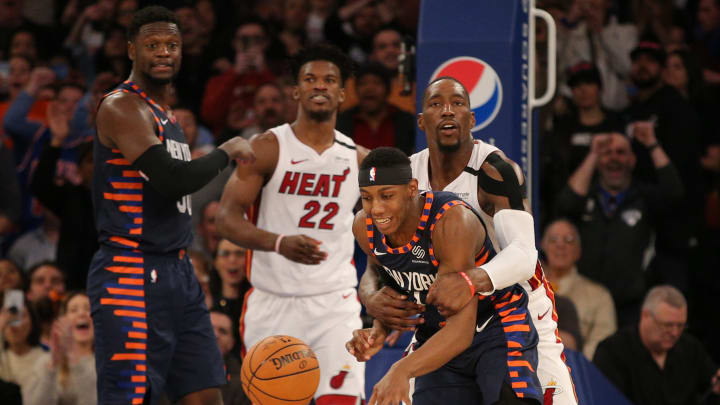Prioritizing Flexibility on the Knicks Roster

Basketball, finally, thankfully, is back.
Is it unwise to draw any meaningful conclusions from these early scrimmages? Very much so. Will we do it anyway? Naturally.
The flavor if the day in the NBA's first helping of organized hoops came from Denver, where Mike Malone has had some fun experimenting with lineups composed of five players who could all credibly play the center position.
Point Jokic? Here for it, because life is too short not to be.
Omfg pic.twitter.com/wGeLcX1gxK
— John Hollinger (@johnhollinger) July 22, 2020
While the Nuggets Mountain Men got a lot of attention, it was another quintet of players who should have been raising the most eyebrows.
At one point during their opening scrimmage against the Sacramento Kings, the Miami Heat sported a lineup composed entirely of wings: Jimmy Butler, Jae Crowder, Andre Iguodala, Derrick Jones Jr. and Tyler Herro.
No point guard. No bigs. No one shorter than 6'5" and no one taller than 6'7".
Following their midseason trade with Memphis, Miami is the latest NBA team that can credibly roll out a lineup of this nature. Houston has gotten the most attention, having gone all-in on small ball after dealing Clint Capella, but Boston has the personnel to pull it off, as do the Clippers. You can also add in Toronto and New Orleans, depending on where Pascal Siakam and Zion WIlliamson fall on your personal positional metric. Others can come close.
What makes Miami so interesting though isn't the lack of a traditional big - that's already old hat in 2020 - but the complete absence of a traditional lead guard. Houston has Harden and Russ, Boston has Kemba and Marcus Smart, Toronto has Lowry and Fred VanVleet, and New Orleans has Jrue Holiday and Lonzo Ball. The Heat, meanwhile, essentially had Butler and Iggy running the show.
For most of the NBA, the focus on getting extra ball-handling on the court has resulted in more and more lineups with multiple point guards. Oklahoma City took it a step further and built this year's team around three, with fantastic results.
Miami - albeit for just a few minutes in a game that didn't count - seemed to be comfortable with going, if not the opposite direction, into a service road along the main highway. The spirit was the same - have more guys that can make quick, smart decisions with the ball and successfully execute those decisions once they're made - but there was no failsafe on the court. Coach Spo trusted that the collective skill and intelligence of his players would make up for the fact that there was no nominal head of the snake.
The Knicks, of course, will not be doing any such experimentation in Orlando. They navigated this season as one of the most traditional teams in the league, and the results spoke for themselves. New York almost always ran one point guard at a time (despite having three on the roster, all of which seemingly had an argument to play), two wings, and then two bigs. They rarely played five players at once who were credible shooting threats, let alone five who would all be considered a threat to do something else with the ball besides fire away.
Instead, they played large (hey, the East is big, man...). Other than perhaps the Lakers, no other team went as heavy on heavies as the Knicks. LA had Lebron to make things hum. The Knicks, not so much.
This failure in roster construction and lineup execution led to a team that, while not the worst in basketball, was arguably the most unwatchable. Rare was the moment when anyone could turn on a Knicks game and feel like they were seeing something sustainable and progressive in light of where the league currently stands. It shouldn't surprise anyone that despite all of the roster additions to a team that finished dead last in assist percentage and effective field goal percentage, New York was once again in the bottom four of both categories.
Luckily, there is hope on the horizon. For one, the Knicks now have a coach, and one who brings with him an impressive if checkered track record when it comes to what he can do on both ends of the court with capable wings. The Knicks will also have an opportunity to make wholesale changes to the roster Tom Thibodeau inherits, with only seven players on fully guaranteed contracts next season.
With no basketball to watch over the last four months, more time has been spent pontificating and re-pontificating New York's roster than just about any other topic. Those conversations usually start with their upcoming lottery pick, and which point guard they should take with the selection.
One argument is that the Knicks should seriously consider going all out to land LaMelo Ball, who is not only the best passer in this draft, but may walk into the league as one of its ten best distributors. It's a philosophy with some merit, assuming the Knicks believe his shooting mechanics can be fixed and his decision making continues to improve.
Killian Hayes, Cole Anthony and Kira Lewis also represent viable options. But this draft also has names at the top like Isaac Okoro and Deni Avdija - non-point guards who nonetheless can function as secondary creators and ball-movers for a good offense.
And then there is Anthony Edwards, perhaps the ultimate wild card. He has prototypical size for a wing and has shown the capability to be an above average passer for his position, but his decision making throughout his freshman year left much to be desired.
As the Knicks contemplate how to built their roster, they'd be wise to pay close attention to what some of the more progressive teams in the NBA are trying out and not be afraid to get a little kooky themselves.
Will Thibs stand in the way of this? He was one of the last coaches standing who insisted on two traditional big men almost at all times, and although his offenses were directed by the occasional combo guard, he always had a nominal point in the game.
But this is also the man who empowered a point-center to direct his offense when Joakim Noah led the Bulls in assists by a healthy margin in the 2013-14 season. It's not like he hasn't been willing to dabble in some experimentation, although he'd probably be the first to admit this non-traditional lineups are not his preferred cup of tea.
Even so, if he's looking at the easiest path to get more of his most versatile pieces on the floor, he might be more willing to bend than he has been in the past. In RJ Barrett and Frank Ntilikina, Thibodeau already has two players who could potentially offer him point guard skills that don't necessarily need to play point guard (both of them learning to shoot would be a necessary caveat here).
Seeking similar player types for the rest of their open roster spots might give them the chance to push what Houston and other teams are doing to the next level: malleability at one through four plus a classic rim-protecting dive-man who also happens to be versatile enough to guard the perimeter. It also might come with a bonus of not necessarily needing to draft a point guard early - something that, while logical in many respects, would also add another weak defensive presence to the roster.
We'll find out which way they go soon enough, as these spots will get filled quickly come the middle of October. Last summer, New York boxed itself into a corner by constructing a roster that almost demanded they play one way and one way only. Thankfully, they didn't box themselves in for too long.
The Knicks have been stuck in the past for too long. With a new leadership team and coach in place, now is the perfect time to step into modernity and give something new a try.
They don't have much, if anything, to lose.
